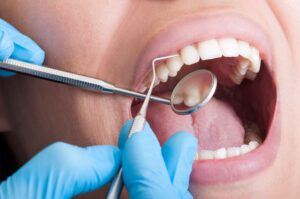
Did you know that the Center for Disease Control and Prevention (CDC) estimates that about 90% of adults who are 20 years or older have had at least one cavity? To make matters worse, it’s possible to have developed one and not know it. They can hide in places you can’t easily see, like behind your molars or between your teeth. Unfortunately, oral issues like this typically don’t heal themselves and only get worse in time. For example, tooth decay can cause an infection that puts neighboring pearly whites at risk.
To avoid this, it’s important to spot the signs of cavities in time to treat them. Keep reading to learn more about how to know if you have hidden tooth decay so you can address it promptly!
What is an Interproximal Cavity?
Interproximal cavities is a term used to describe tooth decay that has developed between two teeth. This happens when harmful bacteria in your mouth break down sugars and carbohydrates into acid that wears down your enamel. These unwanted germs can thrive in places that are harder to reach in order to brush them and cause cavities.
How Do I Know If I Have an Interproximal Cavity?
It’s important to know what signs to look for that let you know you may have a problem so you can contact your dentist. Some potential indicators of interproximal cavities include:
- A sudden toothache or spontaneous pain that occurs without any obvious cause that you can identify.
- You’ve developed sensitivity to hot and cold temperatures around a specific tooth.
- You feel mild to sharp twinges when eating or drinking something overly sweet or spicy.
- Brown, black, or white stains have appeared on the surface of a tooth.
- You experience discomfort when you bite down.
How Can I Prevent Interproximal Cavities?
Although the symptoms listed above can let you know it’s time for a checkup, it’s possible that you won’t experience any of them until the tooth decay has already progressed. Having a consistent at-home dental routine is essential for preventing it from happening in the first place. Thoroughly brushing and flossing your teeth twice daily is a simple and effective way to avoid oral issues because it regularly removes plaque and bacteria buildup.
Also, you should visit your dentist every 6 months for a routine checkup. They’ll examine your mouth for any potential areas of concern, like weakening enamel, and treat it before it gets worse.
Fortunately, it’s not hard to keep your pearly whites clean, and doing so can help protect your smile from hidden cavities!
About the Author
Dr. Michael H. Davies has been providing a wide range of top-tier services to families for over 25 years. He completed his Bachelor of Science in Biology from Saint Michaels College in Vermont and then earned his D.M.D. from Boston University. Today, he stays on top of the most current technology and techniques with ongoing studies and training opportunities. He combines a friendly and compassionate approach with state-of-the-art equipment, so you know you’re getting the best possible care. If you’re concerned that you may have hidden tooth decay, he’s an expert who can help! You’re welcome to request an appointment on the website or by calling (508) 376-5588.

